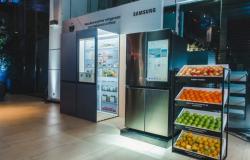He sugar, or at least the excess of it, is increasingly unwelcome in the food industry. Consumer interest in healthy habits, as well as increasing regulatory scrutiny over certain aspects of the sector, are putting certain product categories on the ropes, but providing space for new ones. Thus, the low sugar drinks are giving way to those who help manage blood sugar levels or that are favorable in cases of diabetes.
A new generation of drinks aimed at sugar management is emerging
Proof of this is the Swedish brand Good Idea, launched by Rickard and Björn Öste, Co-Founders of Otaly; food scientist Elin Östman; and Doug Carlson, Co-Founder of the water brand Fiji Water. Their proposal, increasingly popular in markets like the United States, where there is a high percentage of people who suffer from diabetes, consists of sparkling water and different flavors.
However, it differs from other water brands with similar products because it claims to combine five specific amino acids with an essential mineral, chromium picolinate, to effectively reduce the blood sugar spike that occurs after a meal. The brand claims to have carried out years of research and multiple clinical trials to adjust its formula and points out that its drink is capable of reduce sugar spikes in blood by an average of 25%.
As stated on their website, the Good Idea drink helps achieve a more balanced blood sugar level, which contributes to reduce fatigue after meals, sugar cravings and increase concentration and mental clarity. “Maintaining a balanced blood sugar level removes stress from the body, making it easier to maintain a healthy weight and reducing inflammation and risk factors such as type 2 diabetes, cardiovascular disease, dementia and Alzheimer’s“, they say from Good Idea.
The different varieties of the drink bet on natural flavors such as wild raspberry, black currant or Swedish lemon; and are sold in packages of twelve cans at a price of $42 through the brand’s website. The brand is mainly marketed through its e-commerce, but it is gaining ground in the market thanks to its marketing partnerships.
In the United States in recent months it has partnered with the Ike’s Sandwiches chain to offer its drink along with sandwiches; or with Clarks Nutrition, a chain of stores with a focus on natural products. Furthermore, it has also been linked to sport and has served as a sponsor in the Rocky Mountain Pickleball Championships, a pickleball tournament, a sport that combines the rules of tennis and ping pong and that has skyrocketed its growth in the country.
His proposal aims capitalize on a large market. And in the United States there were 38.4 million people with diabetes in 2021, that is, 11.6% of the population. In addition, 1.2 million Americans are diagnosed with diabetes each year. However, their communication strategy does not focus exclusively on diabetes help, but focuses on their health benefits to also target sports enthusiasts, students, gamers or followers of nutrition trends.
Drinks against diabetes
It is practically the same audience that it aims to captivate. A1C Drinks, which he claims to have created “The world’s first diabetic-friendly drinks that can support healthier blood sugar levels and are irresistibly delicious”. As he explains, his drinks are the result of in-depth research and take advantage of the characteristics of natural ingredients such as cinnamon or aloe vera.
“A1C drinks are designed for anyone who craves delicious taste but doesn’t want added sugar or potentially dangerous artificial ingredients or sweeteners.”; they expose. Its formula is based on el erythritolwhich as they explain, is a sugar alcohol that humans cannot digest, so it passes through the body without the negative effects of sugar and is released practically unchanged through urine.
The brand offers its drink in apple, mango and peach flavors, and in packs of 12 cans for $36. Like Good Idea, A1C Drinks is marketed through its online store, but also in physical establishments through a network of local retailers. They are aimed at diabetics, prediabetics, overweight people, people with insulin resistance, but also all those people with special interest in your health and well-being.
Both brands are postulated as alternatives to soft drinks that have been traditionally consumed, such as those proposed by Coca-Cola, Pepsi, Sprite, Fanta or Dr. Pepper, which have been harshly criticized by both health specialists and consumers for their high sugar levels. Thus, they propose healthier options without compromising taste, betting on natural ingredients and staying away from artificial elements.
Their popularity is also growing because they activate increasingly in-demand aspects, such as sustainability, through recyclable packaging; a healthy lifestyle; a attractive design and one digital communication. They also promote convenience through online stores and loyalty programs; and boost their social appeal by partnering with influencers.
However, some health experts are suspicious of the health benefits promised by brands, since although they point to a positive impact in the short term, it is not proven what their effects may be in the long term. Likewise, beyond glucose management, these types of drinks must demonstrate their performance in insulin management.
Related news
Revenue from LVMH’s champagne and fashion lines falls, reflecting luxury slowdown
{“id”:25926,”headline”:”LVMH’s champagne and fashion lines revenue falls, reflecting slowdown in luxury”,”prefix”:null,”slug”:null,”image”:”https ://www.reasonwhy.es/media/cache/noticia_relacionada/media/library/champan-lvmh.jpg”,”path”:”https://www.reasonwhy.es/actualidad/ingresos-ventas-moda-champan -lvmh-deceleration-luxury”}
A Galician drink with seawater, Refix’s proposal to hydrate after physical effort
{“id”:25920,”headline”:”A Galician drink with seawater, Refix’s proposal to hydrate after physical exertion”,”prefix”:null,”slug”:null,”image”:”https ://www.reasonwhy.es/media/cache/noticia_relacionada/media/library/agua-de-mar-refix.jpg”,”path”:”https://www.reasonwhy.es/actualidad/refix-bebida -galician-water-sea-physical-effort”}
However, the interest in drinks that not only contain low levels of sugar but can help reduce blood volume is a reflection of the change that the sector is experiencing. Recently a group of Nestlé shareholders asked the company to reduce its dependence on unhealthy products, and a few weeks ago this same company launched Vital Pursuit, a new brand with products high in protein and aimed at users who consume medications such as Ozempic. or Wegovy to lose weight.
The big soft drink brands, such as Coca-Cola or Pepsi, for their part, are prioritizing its light and zero sugar varieties in their communication and marketing strategies. In addition, they have also strengthened their respective watermarks, innovating in its proposal of flavors and formulas, in a context in which bottled water has reached 16,000 million gallons (60,500 million liters) in sales in 2023 in the United States. A figure that is above the 11.8 billion gallons (44,600 liters) of carbonated soft drinks.






